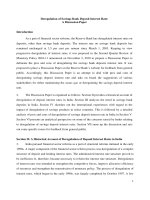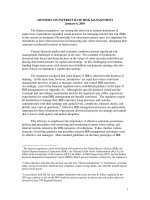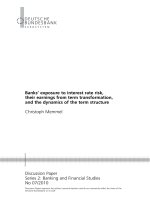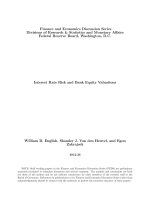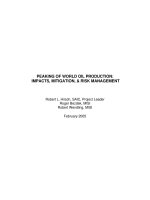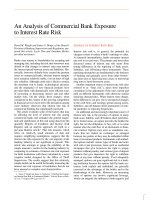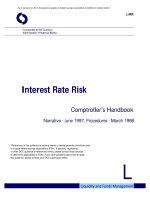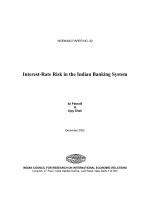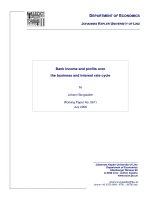STANDARDS OF SOUND BUSINESS PRACTICES - INTEREST RATE RISK MANAGEMENT ppt
Bạn đang xem bản rút gọn của tài liệu. Xem và tải ngay bản đầy đủ của tài liệu tại đây (91.37 KB, 16 trang )
Bank of Jamaica
March 1996
S
S
T
T
A
A
N
N
D
D
A
A
R
R
D
D
S
S
O
O
F
F
S
S
O
O
U
U
N
N
D
D
B
B
U
U
S
S
I
I
N
N
E
E
S
S
S
S
P
P
R
R
A
A
C
C
T
T
I
I
C
C
E
E
S
S
I
I
N
N
T
T
E
E
R
R
E
E
S
S
T
T
R
R
A
A
T
T
E
E
R
R
I
I
S
S
K
K
M
M
A
A
N
N
A
A
G
G
E
E
M
M
E
E
N
N
T
T
©
©
2
2
0
0
0
0
5
5
T
T
h
h
e
e
B
B
a
a
n
n
k
k
o
o
f
f
J
J
a
a
m
m
a
a
i
i
c
c
a
a
.
.
A
A
l
l
l
l
r
r
i
i
g
g
h
h
t
t
s
s
r
r
e
e
s
s
e
e
r
r
v
v
e
e
d
d
Interest Rate Risk Management Page 2
Bank of Jamaica
March 1996
INTEREST RATE RISK MANAGEMENT
A. PURPOSE
This documents sets out the minimum policies and procedures that each institution
needs to have in place and apply within its interest rate risk management programme,
and the minimum criteria it should use to prudently manage and control its exposure to
interest rate risk.
Interest rate risk management must be conducted within the context of a
comprehensive business plan. Although this document focuses on an institution’s
responsibility for managing interest rate risk, it is not meant to imply that interest rate
risk can be managed in isolation from other asset/liability management considerations.
B. DEFINITION
Interest rate risk is the potential impact on an institution’s earnings and net asset
values of changes in interest rates. Interest rate risk arises when an institution’s
principal and interest cash flows (including final maturities), both on- and off-balance
sheet, have mismatched repricing dates. The amount at risk is a function of the
magnitude and direction of interest rate changes and the size and maturity structure of
the mismatch position.
C. INTEREST RATE RISK MANAGEMENT PROGRAMME
Managing interest rate risk is a fundamental component in the safe and sound
management of all institutions. In involves prudently managing mismatch positions in
order to control, within set parameters, the impact of changes in interest rates on the
institution. Significant factors in managing the risk include the frequency, volatility and
direction of rate changes, the slope of the interest rate yield curve, the size of the
interest-sensitive position and the basis for repricing at rollover dates.
Although the particulars of interest rate risk management will differ among institutions
depending upon the nature and complexity of their asset and liability structure (both
on- and off-balance sheet), interest rate risk positions and risk profile, a comprehensive
interest rate risk management programme requires:
establishing and implementing sound and prudent interest rate risk policies;
Interest Rate Risk Management Page 3
Bank of Jamaica
March 1996
developing and implementing appropriate interest rate risk measurement
techniques; and
developing and implementing effective interest rate risk management and
control procedures.
Interest Rate Risk Management Policies
Sound and prudent interest rate risk management requires clear policies. These
policies need to include:
an interest rate risk philosophy governing the extent to which the institution
is willing to assume interest rate risk; and
explicit and prudent limits on the institution’s rate risk exposure.
i) Interest Rate Risk Philosophy
The capacity of each institution to assume rate risk will vary with the extent of other
risks (e.g., liquidity, credit risk, foreign exchange risk, investment risk) and its ability to
absorb potential losses. As with other aspects of financial management, a trade-off
exists between risk and return. Although a fully matched position eliminates interest
rate risk, such a position may not be desirable for other sound business reasons. The
objective of interest rate risk management need not necessarily be the complete
elimination of exposure to changes in interest rates. Rather, it should be to manage
the impact of interest rate changes within self-imposed limits set after careful
consideration of a range of possible interest rate environments.
ii) Interest Rate Risk Limits
Each institution needs to establish explicit and prudent interest rate risk limits, and
ensure that the level of interest rate risk exposure does not exceed these limits.
Interest rate risk limits need to be set within an institution’s overall risk profile, which
reflects factors such as its capital adequacy, liquidity, credit quality, investment risk and
foreign exchange risk. Interest rate positions should be managed within an institution’s
ability to offset such positions if necessary. Moreover, interest rate risk limits need to
be reassessed on a regular basis to reflect potential changes in interest rate volatility,
the institution’s overall risk philosophy and risk profile.
Risk limits are usually defined in terms of earnings or in terms of the present value of
equity at risk and are normally expressed in terms of the allowable amounts of
mismatched positions for specified or cumulative maturity periods.
Interest Rate Risk Management Page 4
Bank of Jamaica
March 1996
Earnings are the reported net income before taxes. Changes in interest rates may
affect earnings by:
affecting the interest income or expenses relating to assets, liabilities and off-
balance sheet items; and
affecting the value of fixed-rate assets, liabilities and off-balance sheet items
that are carried on a market valuation basis.
Present value of equity is the present value of assets and off-balance sheet items
generating cash inflows, less the present value of liabilities and off-balance sheet items
generating cash outflows. Changes in interest rates affect the present value of the cash
flows from, and the value of these items, and therefore the economic value of
shareholders’ equity.
Limits may also appropriately be defined in terms of regulatory capital, shareholders’
equity and earning assets.
Measurement of Interest Rate Risk
Managing interest rate risk requires a clear understanding of the amount at risk and the
impact of changes in interest rates on this risk position. To make these determinations,
sufficient information must be readily available to permit appropriate action to be taken
within acceptable, often very short, time periods. The longer it takes an institution to
eliminate or reverse an unwanted exposure, the greater the possibility of loss.
Each institution needs to use risk measurement techniques that accurately and
frequently measure the impact of potential interest rate changes on the institution. In
choosing appropriate rate scenarios to measure the effect of rate changes, the
institution should consider the potential volatility of rates and the time period within
which the institution could realistically react to close the position.
Gap analysis, duration analysis and stimulation models are interest rate risk
measurement techniques. Each institution should use at least one, and preferably a
combination of these techniques in managing its interest rate risk exposure. Each
technique provides a different perspective on interest rate risk, has distinct strengths
and weaknesses, and is more effective when used in combination with another. These
techniques are discussed further in Appendix A.
Interest Rate Risk Management and Control Procedures
Interest Rate Risk Management Page 5
Bank of Jamaica
March 1996
Each institution needs to develop and implement effective and comprehensive
procedures and information systems to manage and control interest rate risk in
accordance with its interest rate risk policies. These procedures should be appropriate
to the size and complexity of the institution’s interest rate risk-taking activities.
The use of hedging techniques is one means of managing and controlling interest rate
risk. In this regard, many different financial instruments can be used for hedging
purposes the more commonly used, being derivative instruments. Examples include
foreign exchange contracts, foreign currency and interest rate future contracts, foreign
currency and interest rate options, and foreign currency and interest rate swaps.
Generally, few institutions will want or need to use the full range of hedging
instruments. Each institution should consider which are appropriate for the nature and
extent of its interest rate risk activities, the skills and experience of management, and
the capacity of interest rate risk reporting and control systems.
Financial instruments used for hedging are not distinguishable in form from instruments
that may be used to take risk positions. Before using hedging products, each institution
must ensure that they understand the hedging instrument and that they are satisfied
that the instrument matches their specific hedging needs in a cost-effective manner.
Internal inspections/audits are a key element in managing and controlling an
institution’s interest rate risk management programme. Each institution should use
them to ensure compliance with, and the integrity of, the interest rate risk policies and
procedures. Internal inspections/audits should, at a minimum, randomly test all aspects
of interest rate risk management activities in order to:
ensure interest rate risk management policies and procedures are being
adhere to;
ensure effective management controls over interest rate risk positions;
verify the adequacy and accuracy of management information reports; and
ensure that personnel involved in interest rate risk management fully
understand the institution’s interest rate risk policies and risk limits and have
the expertise required to make effective decisions consistent with the interest
rate risk policies.
Assessments of the interest rate risk operations should be presented to the institution’s
Board of Directors on a timely basis for review.
D. ROLE OF THE BOARD OF DIRECTORS
The Board of Directors of each institution is ultimately responsible for the institution’s
exposure to interest rate risk and the level of risk assumed. In discharging this
Interest Rate Risk Management Page 6
Bank of Jamaica
March 1996
responsibility, a Board of Directors usually charges management with developing
interest rate risk policies for the board’s approval, and developing and implementing
procedures to measure, manage and control interest rate risk within these policies.
A Board of Directors needs to have a means of ensuring compliance with the interest
rate risk management programme. A Board of Directors generally ensures compliance
through periodic reporting by management and internal inspectors/auditors which must
provide sufficient information to satisfy the board that the institution is complying with
its interest rate risk management programme.
At a minimum, a Board of Directors should:
review and approve interest rate risk policies based on recommendations by
the institution’s management;
review periodically, but at least once a year, the interest rate risk
management programme;
ensure that an internal inspection/audit function reviews interest rate risk
operations to ensure that the institution’s interest rate risk management
policies and procedures are appropriate and are being adhered to;
ensure the selection and appointment of qualified and competent
management to administer the interest rate risk management function; and
outline the content and frequency of management interest rate risk reports
to the board.
E. ROLE OF MANAGEMENT
The management of each institution is responsible for managing and controlling the
institution’s exposure to interest rate risk in accordance with the interest rate risk
management programme.
Although specific interest rate risk management responsibilities will vary from one
institution to another, management at each institution is responsible for:
developing and recommending interest rate risk policies for approval by the
Board of Directors;
implementing the interest rate risk management policies;
ensuring that interest rate risk is managed and controlled within the interest
rate risk management programme;
Interest Rate Risk Management Page 7
Bank of Jamaica
March 1996
ensuring the development and implementing of an appropriate management
reporting system with respect to the content, format and frequency of
information concerning the institution’s interest rate risk position, in order to
permit the effective analysis and sound and prudent management and
control of existing and potential interest rate risk exposure;
establishing and utilizing a method for accurately measuring the institution’s
interest rate risk positions;
ensuring that an internal inspection/audit function reviews and assesses the
interest rate risk management programme;
developing lines of communication to ensure the timely dissemination of the
interest rate risk policies and procedures to all individuals involved in the
interest rate risk management process; and
reporting comprehensively on the interest rate risk management programme
to the board at least once a year.
Interest Rate Risk Management Page 8
Bank of Jamaica
March 1996
Interest Rate Risk Management Page 9
Bank of Jamaica
March 1996
APPENDIX A
INTEREST RATE RISK MEASUREMENT TECHNIQUES
Gap Analysis
A simple gap analysis measures the difference between the amount of interest-earning
assets and interest-bearing liabilities (both on- and off-balance sheet) that reprice in a
particular time period.
A negative or liability-sensitive gap occurs when interest-bearing liabilities exceed
interest-earning assets for a specific or cumulative maturity period, that is,
more
liabilities reprice than assets. In this situation, a decrease in interest rates should
improve the net interest rate spread in the short term, as deposits are rolled over at
lower rates before the corresponding assets. On the other hand, an increase in interest
rates lowers earnings by narrowing or eliminating the interest spread.
A positive or asset-sensitive gap occurs when interest-earning assets exceed interest-
bearing liabilities for a specific or cumulative maturity period, that is, more assets
reprice than liabilities. In this situation, a decline in interest rates should lower or
eliminate the net interest rate spread in the short term, as assets are rolled over at
lower rates before the corresponding liabilities. An increase in interest rates should
increase the net interest spread.
More sophisticated gap reports measure mismatches of an institution’s principal and
interest cash inflows and outflows (including final maturities), both on- and off-balance
sheet, that reprice in a given period.
Such gap reports measure potential risk to earnings, from changes in interest rates on
these repricing gaps across the institution’s full maturity spectrum. The reports are
important to an interest rate risk management programme because they indicate how
much net interest income is at risk, and, to some extent, the timing of the risk. The
reports provide an objective measure of risk associated with current positions only;
forecasts of future business are not included.
Gap analysis is subject to limitations. Gap analysis does not capture basis risk or
investment risk, is generally based on parallel shifts in the yield curve, does not
incorporate future growth or changes in the mix of business, and does not account for
the time value of money. Moreover, simple gap analysis (based on contractual term to
maturity) assumes that the timing and amount of assets and liabilities maturing within a
specific gap period are fixed and determined, therefore ignoring the effects of principal
and interest cash flows arising from honouring customer drawdowns on credit
Interest Rate Risk Management Page 10
Bank of Jamaica
March 1996
commitments, deposit redemptions, and prepayments, either on mortgages or term
loans, as well as the timing of maturities within the gap period. Depending on the
interest rate environment, the mix of assets and liabilities (both on- and off-balance
sheet), and the exercise of credit and deposit options by customers, these deficiencies
may represent a significant interest rate risk to an institution.
Accordingly, the use of gap reports should be complemented with present-value
sensitivity systems, such as duration analysis or simulation models.
Duration Analysis
Duration is the time-weighted average maturity of the present value of the cash flows
from assets, liabilities and off-balance sheet items. It measures the relative sensitivity
of the value of these instruments to changing interest rates (the average term to
repricing), and therefore reflects how changes in interest rates will affect the
institution’s economic value, that is, the present value of equity. In this context, the
maturity of an investment is used to provide an indication of interest rate risk. The
longer the term to maturity of an investment, the greater the chance of interest rates
movements and, hence, unfavourable price changes.
Duration measures how price-sensitive an asset, liability or off-balance sheet item is to
small changes in interest rates by using a single number to index the institution’s
interest rate risk. This index represents the average term to maturity of the cash flows.
Like other techniques to measure interest rate risk, the use of duration analysis is
subject to limitations. Duration reflects a linear approximation to the price changes that
constitute interest rate risk. However, changes in price and yields do not change
linearly. A member’s portfolio that is duration neutral when interest rates are on one
level will not necessarily be duration neutral at another level – that is, as interest rate
change, duration will also change. This phenomenon is called duration drift.
Moreover, traditional duration analysis assumes that the cash flows of assets and
liabilities are known, which may not always be the case. Option adjusted duration
models may assist in reflecting the variations in cash flows at different points in time
due to the sensitivity of cash flows to changes in interest rates and, as a result of the
exercise of asset and liability options across interest rate environments – that is,
adjusting for events such as term deposit pre-encashments, mortgage and term loan
pre-payments.
Limitations in using duration analysis arise from the fact that matching the average
term or duration of asset and liability cash flows does not eliminate all interest rate risk.
For this reason, duration analysis should be used along with additional interest rate risk
Interest Rate Risk Management Page 11
Bank of Jamaica
March 1996
measures of cash flow mismatch and cash flow dispersion. These additional
measurement techniques are essential if the institution is to control interest rate risks
that cannot be summarised adequately in a single risk measure.
Simulation Models
Simulation models are a valuable complement to gap and duration analysis. Simulation
models analyse interest rate risk in a dynamic context. They evaluate interest rate risk
arising from both current and future business and provide a way to evaluate the effects
of strategies to increase earnings or reduce interest rate risk. Simulation models are
also useful tools for strategic planning; they permit an institution to effectively integrate
risk management and control into the planning process. Their forecasts are based on a
number of assumptions including:
future levels and directional changes of interest rates;
the slope of the yield curve and the relationship between the various indices
that the institution uses to price credits and deposit;
pricing strategies for assets and liabilities as they mature; and
the growth, volume and mix of future business.
Simulation is usually used to measure interest rate risk by estimating what effect
changes in interest rates, business strategies, and other factors will have on net interest
income, net income and interest rate risk positions. Simulation models can also be
used to calculate the present value and durations of assets and liabilities.
Interest Rate Risk Management Page 12
Bank of Jamaica
March 1996
GLOSSARY
Asset/Liability Management
The management and control, within set parameters, of the impact of changes in the
volume, mix, maturity, quality, and interest and exchange rate sensitivity of assets and
liabilities on the institution.
Basis Risk
The risk that the interest rate relationships between an asset and its underlying liability
will change, even if the asset and liability are matched.
Basis risk arises when the interest rate relationship changes between repricing assets
and liabilities within an interest rate risk position – even if asset and liabilities are
matched. This can occur when loan prices are based on one pricing method (e.g.,
Prime) while borrowing costs are based on another.
Credit Risk
The risk of financial loss resulting from the failure of a debtor, for any reason, to fully
honour financial or contractual obligations to the institution.
Duration Analysis
The present-value-weighted average term to repricing of a series of cash flows. In
other words, it is a measure of the average term to repricing and is commonly
expressed in days, months or years. Duration can be calculated for any instrument, or
portfolio of instruments, that has identifiable cash flows.
Foreign Exchange Risk
The exposure of the institution to the potential impact of movements in foreign
exchange rates. The risk is that adverse fluctuations in exchange rates may result in a
loss in Jamaican dollar terms to the institution.
Foreign exchange risk arises when there are unhedged currency mismatches in an
institution’s assets and liabilities, and related cash flows (both on- and off-balance
sheet) which are not subject to a fixed exchange rate vis-à-vis the Jamaican dollar. The
risk continues until the open position is covered by means of a hedging transaction.
Interest Rate Risk Management Page 13
Bank of Jamaica
March 1996
The amount at risk is a function of the magnitude of potential exchange rate changes
and the size and duration of the foreign currency exposure.
Gap Analysis
An analysis of the difference between the amount of rate-sensitive assets and rate-
sensitive liabilities, both on- and off-balance sheet, that reprice in a given period.
Gap Report
A maturity profile report showing the difference between the repricing of assets and
liabilities, both on- and off-balance sheet, within selected time intervals. This report is
usually prepared on the basis of repricing cash flows including final maturity, scheduled
amortisation of principal, and estimated prepayments.
Hedging
A risk management technique to reduce or eliminate price, interest rate or foreign
exchange risk exposures. The elimination or reduction of such exposures is
accomplished by entering into transactions that create offsetting risk positions. The
concept is that when an institution has an open position, which entails a risk that it
wishes to avoid or minimise, the institution can undertake a further transaction which
compensates for the risk and acts as a hedge. If the hedge is effective, any gain or
loss on the hedged risk position will be offset by a loss or gain on the hedge itself.
Interest Rate Gap Positions
See “Mismatch Position”.
Interest Rate Risk
The potential impact of movements in interest rates on the institution.
Interest Rate Risk Position
The amount of the institution’s exposure to interest rate risk.
Interest Rate Sensitive Assets/Liabilities
Interest Rate Risk Management Page 14
Bank of Jamaica
March 1996
Interest-earning assets and interest-bearing liabilities that mature or are repriced within
specified time periods, or have interest rates that float in relation to a base rate such as
the institution’s prime rate.
Interest Rate Sensitive Positions
See “Mismatch Position”.
Interest Rate Yield Curve
The graphic representation of the relationship between financial instruments’ interest
rates and maturity term. A yield curve graph usually has interest rates on the vertical
axis and term-to-maturity on the horizontal axis. When longer maturities have higher
interest rates than shorter maturities, the curve is called a positive or upward-sloping
yield curve. The opposite type of curve is called a negative, downward-sloping, or
inverted yield curve.
Interest Spread
The difference between the yield on the institution’s earning assets and the cost of its
interest-bearing liabilities.
Investment Risk
In the context of interest rate risk management is the exposure of the institution to the
effect of interest rate changes on the market value of the institution’s fixed-rate assets,
liabilities and off-balance sheet items.
Investment risk is the effect of interest rate changes on the market value of fixed-rate
assets, liabilities and off-balance sheet items. Many gap reports ignore that these items
have an imbedded interest rate risk because of the historical pricing of some assets,
liabilities and off-balance sheet items for accounting purposes.
Liquidity
Liquidity is the availability of funds, or assurance that funds will be available, to honour
all cash outflow commitments (both on- an off-balance sheet) as they fall due. These
commitments are generally met through cash inflows, supplemented by assets readily
convertible to cash or through an institution’s capacity to borrow. The risk of illiquidity
may increase if principal and interest cash flows related to assets, liability and off-
balance sheet items are mismatched.
Interest Rate Risk Management Page 15
Bank of Jamaica
March 1996
Matched Position
In the context of interest rate risk management, a matched position occurs when an
institution’s principal and interest cash flows (including final maturities), both on- and
off-balance sheet, have matched repricing dates.
Mismatch Position
Also referred to as interest rate gap or interest rate sensitive positions. In the context
of interest rate risk management, the position that arises when an institution’s principal
and interest cash flows (including final maturities), both on- and off-balance sheet,
have differing repricing dates. A negative or liability-sensitive gap occurs when interest-
bearing liabilities exceed interest-earning assets for a specific maturity, that is, liabilities
reprice before assets. A positive or asset-sensitive gap occurs when interest-earning
assets exceed interest-bearing liabilities for a specific maturity, that is, assets reprice
before liabilities.
Present Value of Equity
The present value of assets and off-balance sheet items generating cash inflows, less
the present value of liabilities and off-balance sheet items generating cash outflows.
Risk Management
The process of controlling the impact of risk-related events on the institution.
Risk Philosophy
A statement of principles and objectives that outlines the institution’s willingness to
assume risk. An institution’s risk philosophy will vary with the nature and complexity of
its business, the extent of other risks assumed, its ability to absorb losses and the
minimum expected return acceptable for a specific level of risk.
Risk Position
The amount of the institution’s exposure to a particular risk.
Simulation Model Analysis
Interest Rate Risk Management Page 16
Bank of Jamaica
March 1996
A dynamic analysis of interest rate risk on an institution arising from both current and
future business, including the effects of strategies to increase earnings or reduce
interest rate risk.

